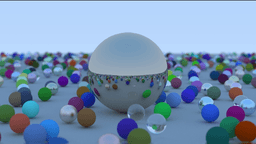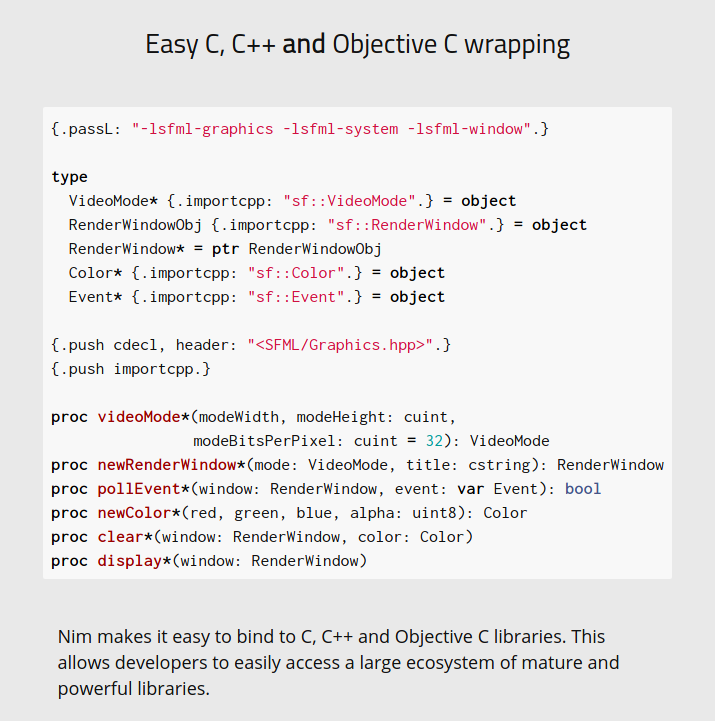mratsim / Trace Of Radiance
Programming Languages
Projects that are alternatives of or similar to Trace Of Radiance
Trace of Radiance
Trace of Radiance is an implementation of Ray Tracing in One Weekend in the Nim programming language
The alledged goals are:
- Learn more about Raytracing
- Have fun
- Serve as a testbed for own multithreading runtime, Weave (TODO)
- Showcase Nim capabilities
In particular, I am convinced (an obviously biaised) that if you want to start a rendering project (raytracing or otherwise) from scratch, Nim is the best language to use, in particular if you are focus on:
- speed
- correctness
- compilation times and compile-time compute
- approachability & development agility
Changelog
The writeup below corresponds to v0.1.0. Since then the following updates (not in Shirley's book) have been made:
- Parallelization via Weave, my own state-of-the-art multithreading runtime.
- Rework of the RNG and sampler for parallel Monte-Carlo simulations
- Simple animation (i.e. no Motion Blur ... yet, only vertical axis, ...)
- Simple physics engine that can simulate gravity and bounce
- Exports animation to PPM series
- Exports animation to MP4 file format:
- RGB to Y'CbCr 420 color conversion (often called YUV)
- Poor Man's H264 encoder
- MP4 Muxer
- ⚠️ Warning: very slow since the engine has no acceleration structures (Bounding Volume Hierarchy, Kd-Trees, ...)
- Credits to https://github.com/nwtgck/ray-tracing-iow-scala for the animation idea.
Table of Contents
Reproducing
git clone https://github.com/mratsim/trace-of-radiance
cd trace-of-radiance
git checkout v0.1.0
nim c -d:danger --outdir:build trace_of_radiance.nim
./build/trace_of_radiance > image.ppm
Speed
Rendering is an extremely time-consuming task. Nim is fast, very fast, even faster than C++ from time to time.
Raytracing in one Weekend
This applies to v0.1.0 of the repo, the repo has been reworked and in particular adds parallelism.
In the RayTracing in One Weekend first book
- Nim 1.2 (GCC 10.1), flag
-d:danger - C++ with GCC 10.1, flag
-O3
On Intel Skylake-X i9-9980XE, overclocked at 4.1GHz all-core turbo. Compiled in x86-64 mode (SSE2 only)
| Nim | C++ |
|---|---|
| 38.577s | 42.303s |
384x216 image, 100 rays per pixel
The Nim sources for this benchmark can be retrived from the first release:
https://github.com/mratsim/trace-of-radiance/tree/v0.1.0
Smallpt
SmallPT is an even smaller raytracing project
Benchmark from Weave multithreading runtime raytracing demo
GCC 10 has a significant OpenMP regression
| Bench | Nim | Clang C++ OpenMP | GCC 10 C++ OpenMP | GCC 8 C++ OpenMP |
|---|---|---|---|---|
| Single-threaded | 4min43.369s | 4m51.052s | 4min50.934s | 4m50.648s |
| Multithreaded | 12.977s | 14.428s | 2min14.616s | 12.244s |
| Nested-parallel | 12.981s | |||
| Parallel speedup | 21.83x | 20.17x | 2.16x | 23.74x |
Single-threaded Nim is 2.7% faster than Clang C++.
Multithreaded Nim via Weave is 11.1% faster Clang C++.
Correctness
Distinct types and modeling physics units
Nim is one of the few languages that can properly model physics units and enforce proper usage of those units at compile-time.
For example, a vector and an unit vector have the same representation but are distinct types. Unit vectors are auto-convertible to vectors when passed to a function:
type
Vec3* = object
x*, y*, z*: float64
UnitVector* {.borrow:`.`.} = distinct Vec3
# The `.` annotation ensures that field access is possible
converter toVec3*(uv: UnitVector): Vec3 {.inline.} =
## UnitVector are seamlessly convertible to Vec3 (but not the otherway around)
Vec3(uv)
Point3 uses the same internal representation as Vec3 and can borrow (share) the implementation of common operators (i.e. no code-size impact)
type Point3* {.borrow: `.`.} = distinct Vec3
# The `.` annotation ensures that field access is possible
func `*=`*(a: var Point3, scalar: float64) {.borrow.}
func `*`*(a: Point3, scalar: float64): Point3 {.borrow.}
func `*`*(scalar: float64, a: Point3): Point3 {.borrow.}
Also:
- Substracting 2 points gives a vector,
- Adding a vector to a point gives a point,
- Adding 2 points is disallowed, with a nice custom error message instead of the compiler default errors.
func `-`*(a, b: Point3): Vec3 {.inline.}=
## Substracting points from one point to the other
## gives a vector
result.x = a.x - b.x
result.y = a.y - b.y
result.z = a.z - b.z
func `+`*(p: Point3, v: Vec3): Point3 {.inline.}=
## Adding a vector to a point results in a point
Point3(Vec3(p) + v)
func `-`*(p: Point3, v: Vec3): Point3 {.inline.}=
## Substracting a vector to a point results in a point
Point3(Vec3(p) - v)
func `+`*(a, b: Point3): Point3 {.error: "Adding 2 Point3 doesn't make physical sense".}
I also have 2 types for colors and their attenuations (in percentage), so you cannot multiply colors:
type Color* {.borrow: `.`.} = distinct Vec3
func `*`*(a, b: Color): Color {.error: "Multiplying 2 Colors doesn't make physical sense".}
type Attenuation* {.borrow: `.`.} = distinct Color
func `*=`*(a: var Attenuation, b: Attenuation) {.inline.} =
# Multiply a color by a per-channel attenuation factor
a.x *= b.x
a.y *= b.y
a.z *= b.z
func `*`*(a, b: Attenuation): Attenuation {.inline.} =
# Multiply a color by a per-channel attenuation factor
result.x = a.x * b.x
result.y = a.y * b.y
result.z = a.z * b.z
func `*=`*(a: var Color, b: Attenuation) {.inline.} =
# Multiply a color by a per-channel attenuation factor
a.x *= b.x
a.y *= b.y
a.z *= b.z
Last but not least, ensure you don't mix and match degrees and radians, with auto-conversion of radians to float (and degree would stay at a higher level)
type
Degrees* = distinct float64
Radians* = distinct float64
template degToRad*(deg: Degrees): Radians =
Radians degToRad float64 deg
template radToDeg*(rad: Radians): Degrees =
Degrees radToDeg float64 rad
# For now we don't create our full safe unit library
# with proper cos/sin/tan radians enforcing
# and auto-convert to float
converter toF64*(rad: Radians): float64 {.inline.} =
float64 rad
Tracking mutability
When using value types (stack objects, seq and strings), Nim requires an
explicit var when passing parameters or assigning to a variable for
a parameter to be mutable.
This makes it clear what can or can't move under your feet.
Furthermore, C and C++ developers might be interested to know that when passing a large object (over 12 bytes on 32-bit and 24 bytes on 64-bit platforms), Nim does the Right Thing™ and will pass by reference by default (you can override that on a per-type basis to always pass-by-copy or always by reference). This means that function signatures are motivated by mutability concerns and uncluttered from performance (and performance is great as proven by the benchmarks)
Tracking side-effects
Nim functions can be declared with proc or func.
A func enforces the absence of side-effect or the code will not compile. For example:
- (non-deterministic) random functions
- accessing a global variable
- multithreading
- IO
If you have a Heisenbug, it's likely not in a side-effect free function (unless you corrupt memory)
This is particularly suited to physics and raytracing computational kernels as physics equations are side-effect free.
Compilation times & Meta-programming
Despite all its features, Nim compiles extremely fast with both C and C++ targets. In particular template metaprogramming has a low low low compilation-time cost.
Nim is the language with the widest support for compile-time metaprogramming, including dependently-typed languages.
This is supported by a fast VM that gives Nim the speed of Python at compile-time and is used for:
- Writing domain specific languages
- State machine generators
- Seamless multidimensional arrays uses, including Einstein summation
- Shader generators
- SIMD kernel generators
- ...
- Sompile-time precomputations
- Buffers, vectors, matrices parametrized by integer generics
C and C++ interop
Nim can compile to both C and C++ and seamlessly call libraries written in either languages. It can even use CUDA with a bit of configuration to call nvcc
For example, bindings to SFML, from the Nim website features
Approachability, productivity & development agility
While Nim offers many advanced features, it does not force you to swim or drown
on first approach.
Actually many people have reported that Nim felt like a compiled scripting language.
Caveats
Not all is ponies and rainbows, Nim's main issue is that it is a very young language with a small ecosystem of support libraries. That said, you can reuse the C and C++ ecosystem (and Javascript as well since Nim can also compile to it).



